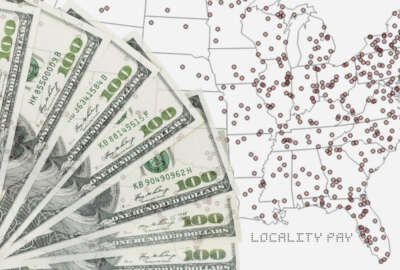For General Schedule employees, pay compression got a little worse in 2024
After the latest 5.2% federal pay raise, pay compression now applies to 60% of locality pay areas, with some senior-level feds in 35 of the 58 areas hitting an ...
We’re in a new year, and that means federal employees working across the country are about to get a sizeable raise added to their next paychecks.
President Joe Biden made the average 5.2% raise official right before Christmas. But while most career feds on the General Schedule will get a raise somewhere around that percentage, thousands of those in the uppermost ranks of the GS pay system will see their paychecks short-changed.
That’s because of an arbitrary pay cap that exists for General Schedule pay rates. Salaries of career GS employees, according to federal statute, cannot exceed the pay for political appointees and others at level IV on the Executive Schedule.
For a long time, the pay cap impacted only the longest-serving and topmost-ranked GS-15s. But just in the last year or so, pay compression has extended down to some GS-14s as well.
The salaries of these senior-level feds do increase with annual federal pay raises, but the pay ceiling means they don’t reach their “full” raises — and that has impacts lasting well into retirement too (more on that later).
For 2024, any GS grade or step that would be put above $191,900 due to the pay raise will see their pay compressed down to that amount.
The grades and steps that pay compression affects also vary nationwide. Depending on the locality pay area, exactly whose pay gets compressed looks a little different.
Using Office of Personnel Management data, Federal News Network compiled the chart below showing exactly which steps and grades are impacted in each of the locality pay areas that experience pay compression.
(Story continues below)
With the latest 5.2% raise, pay compression now applies to the majority of locality pay areas, affecting 35 of the 58 total areas to some extent. That means in 60% of the existing locality pay areas, at least one step of at least one pay grade is hitting the arbitrary pay ceiling.
By comparison, there were 25 locality pay areas in the pay cap club in 2020 — the last time Federal News Network conducted a locality-by-locality analysis.
Over time, after years of pay raises for most GS employees, coupled with no or reduced raises for others, the problem of pay compression is getting worse.
In 2024, GS-15, step 10, employees in Albany, New York, and Austin, Texas, will begin experiencing pay compression for the first time.
Adding to the troubles, the pool of federal employees whose pay has been capped expanded within six different locality pay areas this year.
Pay compression is noticeably worse in one region in particular: the San Jose-San Francisco-Oakland, California, locality pay area. It’s the only area where the pay ceiling is low enough for GS-14s to hit it, now reaching steps 9 and 10 on that pay band.
The next step down in the Bay Area — GS-14, step 8 — is just a couple thousand dollars below the $191,900 pay ceiling too. For 2024, employees situated there will get a salary of $187,598.
In a couple other geographic regions, some feds are just a few metaphorical inches from the pay ceiling. For example, GS-15, step 7, employees in Denver, Colorado, are just $136 shy of the cap this year.
On the other end of things, some senior-level feds have had their pay compressed for years.
“I consider GS-15, step 10s, like me, to be well-compensated in the grand scheme of things — with that said, it’s more about the principle,” one FNN reader wrote in a recent email to me. “The deal is supposed to be that federal employees get promoted from grade to grade as they show potential and take on greater and greater responsibility, and then, within their grade, receive step increases based on years of experience.”
The pay caps not only limit an employee’s take-home pay during a given year, but could also cost future annuitants during retirement — particularly when calculating their “high-three,” the average of the highest three consecutive years of salaries that help determine federal annuity payments.
The pay cap can make a difference of thousands of dollars in retirement annuities, according to Federal News Network’s analysis from 2020.
“I recognize that the last couple of years, we have received a greater proportion of the raise, but even if the cap was raised to $300,000 next year, we will never be made whole for what we were promised and have already lost,” the anonymous fed said.
The Senior Executives Association — an advocacy group that’s been particularly vocal about pay compression — pointed to ripple effects of the pay challenge as well.
“This issue does not incentivize federal employees to pursue senior executive positions in the government and contributes to morale challenges, as evidenced by the recent Federal Employee Viewpoint Survey results indicating just 57% of federal employees are satisfied with their pay — down 10% from 2020,” SEA President Marcus Hill said in a Dec. 27 statement. “Despite a bipartisan recognition of this problem, pay compression remains a real issue.”
OPM declined to provide Federal News Network with data on how many federal employees experience pay compression nationwide, but by some estimates, about 30,000 GS employees and 2,500 Senior Executive Service, Senior-Level, and Scientific and Professional employees are affected by pay compression, said Jason Briefel, partner and director of government and public affairs at Shaw Bransford & Roth.
“The joy many federal employees felt will quickly turn to frustration when tens of thousands of feds realize they will not receive this raise because their pay is capped,” Briefel wrote in an email. “This serves as a major disincentive to promote and advance within the government and causes many excellent federal employees to leave for other sectors each year, often to government contractors where they can earn double or more the salary while still working on the same mission.”
In the fiscal 2024 budget request, the Biden administration hinted at plans to issue a legislative proposal aiming to address the worsening challenge of pay compression. But so far, no proposal has been made publicly available.
“We are continuing to work through those issues, through our channels in the government,” OPM Deputy Director Rob Shriver said in a recent interview. “We hope to have more to be able to tell you about that soon.”
And even after a potential legislative proposal from the Biden administration, it would still be up to Congress to actually make the change.
Federal News Network’s Jared Serbu contributed to this report.
Copyright © 2024 Federal News Network. All rights reserved. This website is not intended for users located within the European Economic Area.
Drew Friedman is a workforce, pay and benefits reporter for Federal News Network.
Follow @dfriedmanWFED






